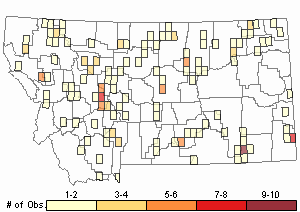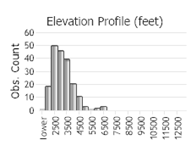View in other NatureServe Network Field Guides
NatureServe
Montana
Utah
Wyoming
Idaho
Wisconsin
British Columbia
South Carolina
Yukon
California
New York
Tadpole Physa - Physella gyrina
Other Names:
Physa gyrina
Native Species
Global Rank:
G5
State Rank:
SNR
(see State Rank Reason below)
Agency Status
USFWS:
USFS:
BLM:
External Links
State Rank Reason (see State Rank above)
Currently this species is found state-wide and in a variety of habitats often in large densities.
General Description
This ubiquitous, left-handed snail species is distributed in temerpate and sub-Arctic North America from southern Alaska and northwestern Canada (but not in the extreme north) east and southeast to central Labrador, western New England and the vicinity of New York City; south to central California, Nevada, Utah, and Colorado (Taylor 2003). (Burch 1989) lists several supposed synonyms including Physella gyrina gyrina from Canada, Quebec to Ontario south to Nebraska and east to New York. This snail can be found in a variety of habitats from lakes, ponds, streams, ditches, and marshes (Taylor 2003). Like most snails, these are herbivorous-scrapers of algae, detritus and diatoms from vegetation and off other benthic substrates.
Diagnostic Characteristics
If live specimens are being evaluated, this species may be distinguished from P. acuta easily by looking at the animals’ bodies. P. gyrina has very obvious whitish pigment spots on a dark grey ground, over the whole body including the tentacles, whereas P. acuta lacks spotting and ground color is more variable ranging from a pale grey to blue-grey or even black. The spire of P. gyrina is conical, flat sided, and the sutures between whorls is shallower, while the shell of P. acuta has a more rounded spire with less steep angles
Range Comments
Currently this species is found state-wide.
Observations in Montana Natural Heritage Program Database
Number of Observations: 220
(Click on the following maps and charts to see full sized version)
Map Help and Descriptions
Relative Density

Recency



 (Observations spanning multiple months or years are excluded from time charts)
(Observations spanning multiple months or years are excluded from time charts)
Migration
No populations of this species make local extended movements (generally less than 200 km) at particular times of the year (e.g., to breeding or wintering grounds, to hibernation sites).
Habitat
P. gyrina tends to live in clear to turbid waters in the marginal zones of large lakes, ponds, and rivers and can be found in the shallow margins or in marshy pools along shorelines
Ecological Systems Associated with this Species
- Details on Creation and Suggested Uses and Limitations
How Associations Were Made
We associated the use and habitat quality (common or occasional) of each of the 82 ecological systems mapped in Montana for
vertebrate animal species that regularly breed, overwinter, or migrate through the state by:
- Using personal observations and reviewing literature that summarize the breeding, overwintering, or migratory habitat requirements of each species (Dobkin 1992, Hart et al. 1998, Hutto and Young 1999, Maxell 2000, Foresman 2012, Adams 2003, and Werner et al. 2004);
- Evaluating structural characteristics and distribution of each ecological system relative to the species' range and habitat requirements;
- Examining the observation records for each species in the state-wide point observation database associated with each ecological system;
- Calculating the percentage of observations associated with each ecological system relative to the percent of Montana covered by each ecological system to get a measure of "observations versus availability of habitat".
Species that breed in Montana were only evaluated for breeding habitat use, species that only overwinter in Montana were only evaluated for overwintering habitat use, and species that only migrate through Montana were only evaluated for migratory habitat use.
In general, species were listed as associated with an ecological system if structural characteristics of used habitat documented in the literature were present in the ecological system or large numbers of point observations were associated with the ecological system.
However, species were not listed as associated with an ecological system if there was no support in the literature for use of structural characteristics in an ecological system,
even if point observations were associated with that system.
Common versus occasional association with an ecological system was assigned based on the degree to which the structural characteristics of an ecological system matched the preferred structural habitat characteristics for each species as represented in scientific literature.
The percentage of observations associated with each ecological system relative to the percent of Montana covered by each ecological system was also used to guide assignment of common versus occasional association.
If you have any questions or comments on species associations with ecological systems, please contact the Montana Natural Heritage Program's Senior Zoologist.
Suggested Uses and Limitations
Species associations with ecological systems should be used to generate potential lists of species that may occupy broader landscapes for the purposes of landscape-level planning.
These potential lists of species should not be used in place of documented occurrences of species (this information can be requested at:
mtnhp.mt.gov/requests) or systematic surveys for species and evaluations of habitat at a local site level by trained biologists.
Users of this information should be aware that the land cover data used to generate species associations is based on imagery from the late 1990s and early 2000s and was only intended to be used at broader landscape scales.
Land cover mapping accuracy is particularly problematic when the systems occur as small patches or where the land cover types have been altered over the past decade.
Thus, particular caution should be used when using the associations in assessments of smaller areas (e.g., evaluations of public land survey sections).
Finally, although a species may be associated with a particular ecological system within its known geographic range, portions of that ecological system may occur outside of the species' known geographic range.
Literature Cited
- Adams, R.A. 2003. Bats of the Rocky Mountain West; natural history, ecology, and conservation. Boulder, CO: University Press of Colorado. 289 p.
- Dobkin, D. S. 1992. Neotropical migrant land birds in the Northern Rockies and Great Plains. USDA Forest Service, Northern Region. Publication No. R1-93-34. Missoula, MT.
- Foresman, K.R. 2012. Mammals of Montana. Second edition. Mountain Press Publishing, Missoula, Montana. 429 pp.
- Hart, M.M., W.A. Williams, P.C. Thornton, K.P. McLaughlin, C.M. Tobalske, B.A. Maxell, D.P. Hendricks, C.R. Peterson, and R.L. Redmond. 1998. Montana atlas of terrestrial vertebrates. Montana Cooperative Wildlife Research Unit, University of Montana, Missoula, MT. 1302 p.
- Hutto, R.L. and J.S. Young. 1999. Habitat relationships of landbirds in the Northern Region, USDA Forest Service, Rocky Mountain Research Station RMRS-GTR-32. 72 p.
- Maxell, B.A. 2000. Management of Montana's amphibians: a review of factors that may present a risk to population viability and accounts on the identification, distribution, taxonomy, habitat use, natural history, and the status and conservation of individual species. Report to U.S. Forest Service Region 1. Missoula, MT: Wildlife Biology Program, University of Montana. 161 p.
- Werner, J.K., B.A. Maxell, P. Hendricks, and D. Flath. 2004. Amphibians and reptiles of Montana. Missoula, MT: Mountain Press Publishing Company. 262 p.
Food Habits
Like most snails, these are herbivorous- scrapers of algae, detritus and diatoms from other vegetation of benthic substrates
Ecology
P. gyrina tends to live in clear to turbid waters in the marginal zones of large lakes, ponds and rivers and can be found in the shallow margins or in marshy pools along shorelines
Stewardship Responsibility
References
- Literature Cited AboveLegend:
 View Online Publication
View Online Publication Burch, J.B. 1989. North American freshwater snails. Malacological Publications: Hamburg, Michigan. 365 pp.
Burch, J.B. 1989. North American freshwater snails. Malacological Publications: Hamburg, Michigan. 365 pp. Taylor, D.W. 2003. Introduction to Physidae (Gastropoda: Hygrophila); biogeography, classification, morphology. Revista de biología tropical, 51, pp.1-+.
Taylor, D.W. 2003. Introduction to Physidae (Gastropoda: Hygrophila); biogeography, classification, morphology. Revista de biología tropical, 51, pp.1-+.
- Additional ReferencesLegend:
 View Online Publication
View Online Publication
Do you know of a citation we're missing? Berry, S.S. 1913. A list of Mollusca from the Mussellshell Valley, Montana. Nautilus 26:130-131.
Berry, S.S. 1913. A list of Mollusca from the Mussellshell Valley, Montana. Nautilus 26:130-131. Berry, S.S. 1916. Notes of Mollusca of central Montana. Nautilus 29:124-128.
Berry, S.S. 1916. Notes of Mollusca of central Montana. Nautilus 29:124-128. Gillespie, D.M. 1966. Population studies of four species of mollusks in the Madison River, Yellowstone National Park. Ph.D. Dissertation. Bozeman, Montana: Montana State University. 43 p.
Gillespie, D.M. 1966. Population studies of four species of mollusks in the Madison River, Yellowstone National Park. Ph.D. Dissertation. Bozeman, Montana: Montana State University. 43 p. Heaton, J.R. 1966. The benthos and drift fauna of a riffle in the Madison River, Yellowstone National Park. Ph.D. Dissertation. Bozeman, Montana: Montana State University. 59 p.
Heaton, J.R. 1966. The benthos and drift fauna of a riffle in the Madison River, Yellowstone National Park. Ph.D. Dissertation. Bozeman, Montana: Montana State University. 59 p. Hendricks, P., S. Lenard, D.M. Stagliano, and B.A. Maxell. 2013. Baseline nongame wildlife surveys on the Fort Peck Indian Reservation. Report to the Assiniboine and Sioux Tribes of the Fort Peck Indian Reservation. Montana Natural Heritage Program, Helena, MT. 83 p.
Hendricks, P., S. Lenard, D.M. Stagliano, and B.A. Maxell. 2013. Baseline nongame wildlife surveys on the Fort Peck Indian Reservation. Report to the Assiniboine and Sioux Tribes of the Fort Peck Indian Reservation. Montana Natural Heritage Program, Helena, MT. 83 p. Lehmkuhl, Dennis M. 1966. A study of the littoral invertebrates of three mountain lakes in Glacier National Park, Montana. M.A. Thesis. University of Montana. Missoula, MT.
Lehmkuhl, Dennis M. 1966. A study of the littoral invertebrates of three mountain lakes in Glacier National Park, Montana. M.A. Thesis. University of Montana. Missoula, MT. Russell, R.H. and R.B. Brunson. 1967. A check-list of molluscs of Glacier National Park, Montana. Sterkiana 26:1-5.
Russell, R.H. and R.B. Brunson. 1967. A check-list of molluscs of Glacier National Park, Montana. Sterkiana 26:1-5. Squyer, H. 1894. List of shells from the vicinity of Mingusville, Montana. The Nautilus 8:63-65.
Squyer, H. 1894. List of shells from the vicinity of Mingusville, Montana. The Nautilus 8:63-65.
- Web Search Engines for Articles on "Tadpole Physa"
- Additional Sources of Information Related to "Snails / Slugs"





